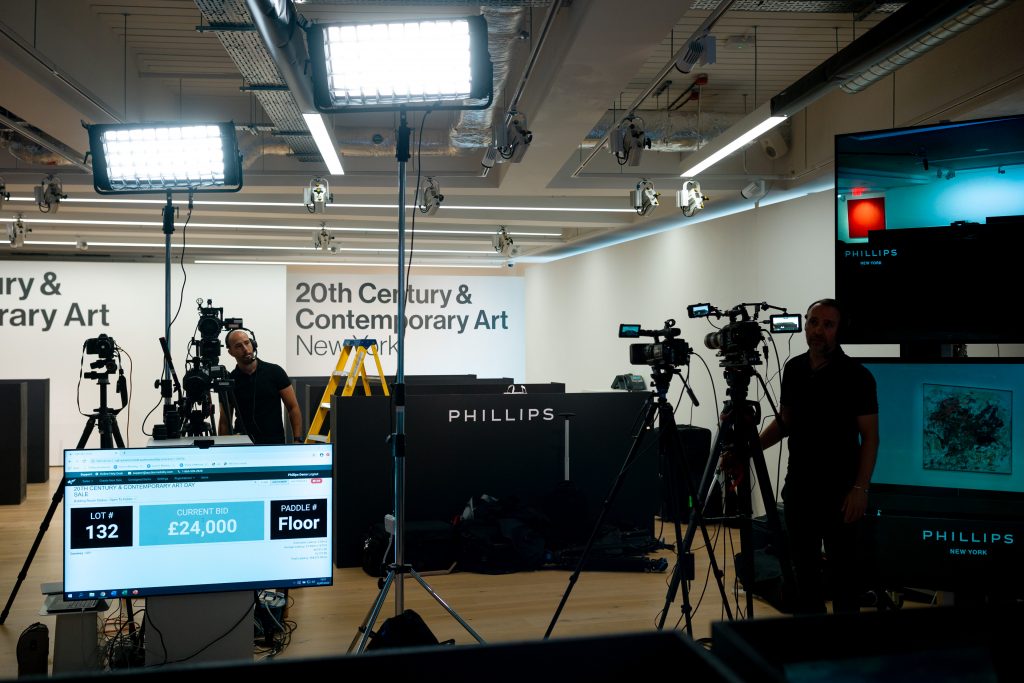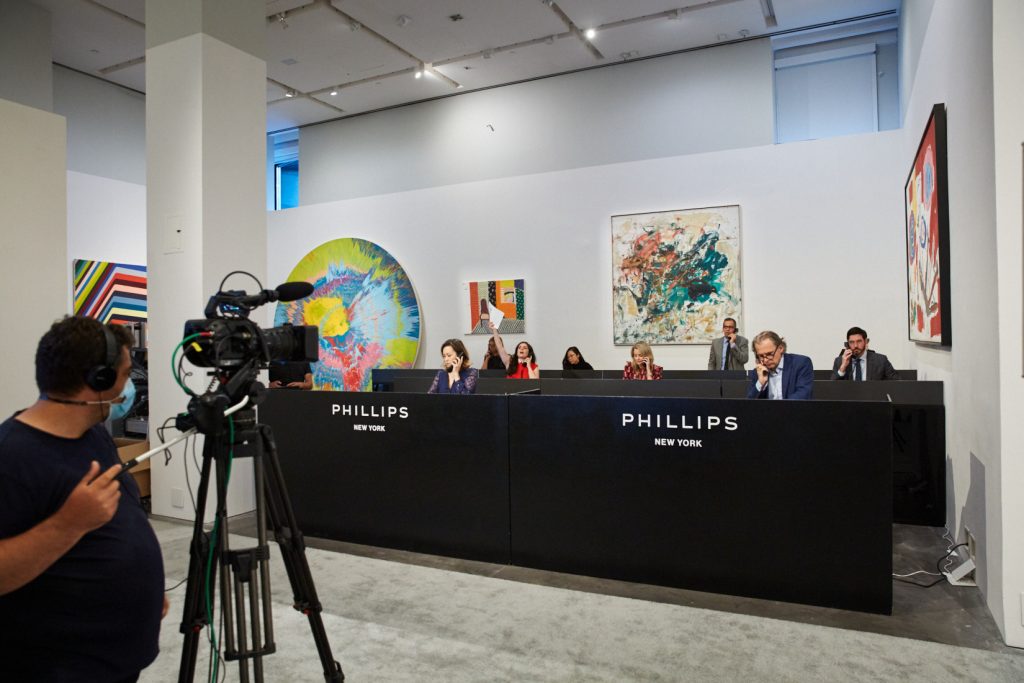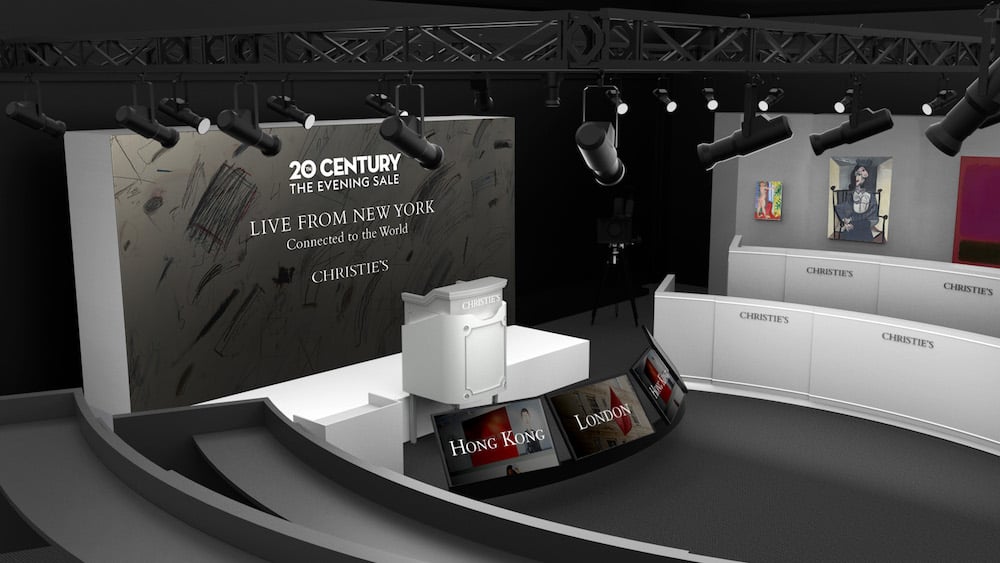Although the ground has shifted early and often beneath the art market during this very strange year, the world’s premier auction houses find themselves in the midst of a more favorable transition here in early October. After spending much of the shutdown racing to assemble viable platforms for high-level selling in a mixed online-IRL format, the successes and shortcomings that Christie’s, Sotheby’s, and Phillips experienced in their major midsummer hybrid sales (where they collectively moved over $825 million in art) have now equipped them to come back bigger and better for the fall.
So what worked—and, just as importantly, what didn’t? As the Big Three auction houses continue their quest to hammer down deals in a socially distanced world, how exactly will they apply the summer’s lessons to the rest of the 2020 sales calendar?
Artnet News’s market team consulted experts from Christie’s, Sotheby’s, and Phillips to find out what they’ve learned. The answers may surprise you.
1. Hybrid Formats Level the Bidding Field

Francis Bacon, Triptych Inspired by the Oresteia of Aeschylus (1981). Image courtesy of Sotheby’s
E-bidding isn’t new to auction houses, but it achieved a new level of prominence in this summer’s hybrid sales. Perhaps the most indelible expression of the shift arrived when an online bidder went mano a mano with a phone bidder past $70 million for Francis Bacon’s Triptych Inspired by the Oresteia of Aeschylus (1981) at Sotheby’s marathon evening sale on June 29. (The victor on the phone ultimately paid a premium-inclusive $84.6 million for the trophy.) According to Oliver Barker, chairman of Sotheby’s Europe and the man holding the gavel in that historic sale, the digital power surge came partly from the design solutions achieved by the monitor-rich command center from which he worked.
“Online bidders are presented to the auctioneer in exactly the same way as the telephone bidders, with their own dedicated screen in front of the auctioneer,” Barker explains. “In this way, auctioneers are able to interact and engage with online participants more closely than ever before.” The greater interactivity and increased primacy means digital paddle-wavers occupy equal footing with their competitors—and that’s a major plus for any house’s bottom line.
2. Stay Calm and Sell Privately

The phone back in the makeshift studio London salesroom. Photo courtesy Phillips/Mediakite and Thomas De Crudon Perrior
Phillips’s initial response to the shutdowns in March was to take a breath. “There’s a Dutch saying: If you’re getting a shave, then you gotta sit still,” says Jean-Paul Engelen, deputy chairman and worldwide co-head of 20th century & contemporary art. “If there’s a lot of danger flying around you, stay calm, relax, and see what happens. There was no panic. It was just, ‘May’s not gonna work, let’s make certain all our staff is fine, let’s assemble a great team, and let’s start building something.’”
After the initial shock, the next move was to divert energy from the live-sales operations that had shut down globally and focus on private sales that could take place in one-on-one transactions. “The first three things we thought about were: private sales, private sales, private sales,” Engelen says.
3. Auction House Be Nimble, Auction House Be Quick

The sale room getting ready for a livestream. Photo courtesy Phillips/Mediakite and Thomas De Cru…don Perrior)
After its initial pivot to private sales, Phillips started to mess around with the long-sacrosanct auction week calendar, moving its May auctions to July with somewhat more ease than its two competitors, both of which have significantly larger operations. Another benefit of being a smaller house: avoiding mass layoffs (and an accompanying brain drain). “We’re a nimble house and if you’re in a smaller boat, it’s easier to maneuver,” Engelen says. “We didn’t have any layoffs—we didn’t have anyone fall out of the boat. We had a very steady course.”
4. Your Imagination—and Your Tech—Are Your Limitations

Sotheby’s salesroom in New York during its June 2020 evening sale. Photo: Sotheby’s.
This summer also highlighted just how far houses’ reach could extend for premier sales if they think digital first. Sotheby’s claims more than 150,000 viewers tuned in to its London-based June mega-sale across all available formats. Leadership was so encouraged by the results that the house will aggressively expand its hybrid live-streamed auctions into Hong Kong and Paris this fall.
Sotheby’s Hong Kong contemporary evening sale on October 6 will be the next to adopt the blended online-offline approach, including patching in bidding desks from London and New York to accommodate the sizable participant pool from outside Asia. (One-third of bidders in the house’s July Hong Kong sale came from beyond the continent, according to Sotheby’s.) The hybrid format will also animate “Modernités/Contemporary,” a pair of Modern and contemporary sales that will be held back-to-back in Paris and London, respectively, on October 21.
Another major expansion comes courtesy of a new media partner. In addition to livestreaming on their own web and Facebook feeds, Sotheby’s will be broadcasting “Modernités/Contemporary” live on Museum TV, the French television channel that produces more than 300 hours of accessible arts programming for 1.4 million viewers every year. It’s a natural next step as auction houses embrace their sales as bona fide entertainment. “We have moved from the live theater business into the world of live television,” Oliver Barker says.
5. Save the Trees—and Weeks Clients Can Consign

Auctioneer Henry Highly taking bids in the London studio. Photo courtesy Phillips/Mediakite and Thomas De Crudon Perrior
Another bold move from the houses was to significantly pare back the physical auction catalogue—long a staple of the in-person evening sale, but, to some, a dead-tree relic of the past. By July, Phillips had bound its evening, morning and afternoon auctions within a single slim tome. Those lengthy essays, side-by-side artwork comparisons, and lengthy consignor bios? All shunted to the digital realm, accessible by QR code. The house plans to limit the literature for the fall sales, too.
It’s a green-leaning initiative, sure. But eliminating the paper catalogues also greatly increases flexibility by extending the hard deadline for adding consignments to major sales. In the past, a finalized list had to be sent to the printer weeks in advance. Now, as Jean-Paul Engelen notes, the more modest catalogues can be altered basically up until the sale, opening a much larger window for specialists to secure big-ticket works.
6. Pivot to Video

A cameraman getting the right angle at Phillips. Photo courtesy Phillips/Mediakite and Thomas De Cru…don Perrior)
Almost immediately, the Big Three houses had to shift from hosting their marquee events in packed salesrooms to sequestering the auctioneers in sanitized studios, where they would take bids from specialists on other continents via satellite feed. The gambit paid off well enough that Phillips, for one, is doubling down. They’ve recently moved to a bigger studio, one where eight different cameras will be able to capture the London-based auctioneer Henry Highley as he takes bids from his English colleagues in person, as well as salesrooms in New York and Hong Kong. He’ll also be monitoring scores of clients pinging in from their laptops, with top-of-the-line tech allowing for seamless interactions across the oceans.
“We secured what we called a Super Bowl-level connection,” Jean-Paul Engelen says. “You can hire one of those high-tech lines so there’s no time lag between London and New York.”
7. One Auctioneer Is Better Than Four

Image courtesy Christie’s.
After its first-ever livestreamed evening sale on July 10—which kicked off in Hong Kong before moving to Paris, London, and New York—Christie’s seems to have internalized the benefits of centralization. The four-city, four-auctioneer model resulted in over-talking, overlapping bids, and some general confusion (including juggling four different currencies). When London based-auctioneer Jussi Pylkkanen announced during the bidding for a Pierre Soulages painting, “I’m selling it at…,” he was interrupted by Cécile Verdier, head of Christie’s France, who wrested back control of the lot, saying emphatically, “No! I’m selling it!”
“Was it perfect?” Alex Rotter, Christie’s co-head of the 20th and 21st Centuries team, said during a press preview this week of its experimental first effort. “No. We’re learning. We’re now three months further along.”
At Christie’s next big evening sale on October 6, titled 20th-Century, just one auctioneer—veteran Adrien Meyer, Christie’s global head of private sales—will take the rostrum, making for a more streamlined process. He will beam from a single, sleeker venue in New York (see the set above).
The new design, according to Meyer, will “bring the auctioneer into the center of the proceedings” to “create an even richer and more dynamic viewing experience… while still honoring the tradition and magic of a New York evening sale at Christie’s.” Though bidders will not actually be in the room, the format was developed to be flexible so that the house could easily adapt the setup for in-person attendees “when that day comes.”
8. The New Calendar Means “Carte Blanche”

Christie’s will offer a near complete skeleton of a T-Rex named Stan at its upcoming evening sale. Image courtesy Christie’s.
One big lesson Christie’s internalized as it became clear that lockdown would be more than a few-week affair: the relative unimportance of traditional sale timing and categories.
That’s part of the reason the house front-loaded some of its most high-profile lots in its new October sale, rather than waiting for the traditional New York event in November—a month that shares with the US presidential election and flu season. “Any election has an impact on the market, whatever the outcome,” Rotter said in a press preview. Ahead of an election whose results may not be clear, let alone accepted by the current White House inhabitant, it becomes an even bigger liability. “If we have an auction when there’s no president elected, I see that as a problem,” Rotter said.
Dates aren’t the only tradition that is going out the window. Christie’s has also added a massive T-Rex skeleton named “Stan” to its art evening sale. The rationale, according to the house? Evening sales are understood by collectors to be the best platforms for exceptional items—and in this case, that includes a dinosaur skeleton.
To be fair, if this past auction season has taught houses anything, it’s that in 2020, you have to push the envelope to avoid extinction.















